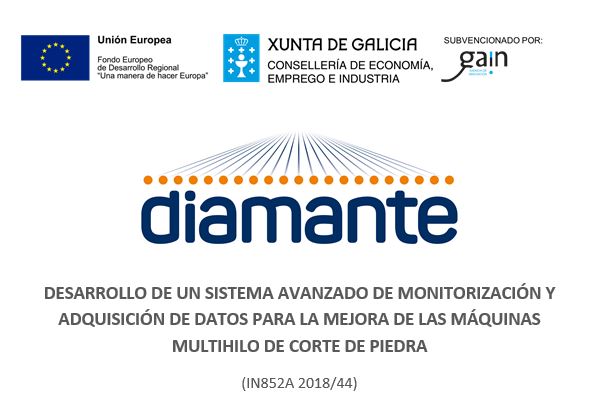The importance of the granite sector in the Galician economy is fundamental. The Galician granite industry is the 2nd most important in Europe (after Italy) and the 5th in the world, appearing ahead of powers such as Belgium, Portugal or Germany.
In this context, the DIAMANTE project represents an opportunity for Galicia to increase production and improve the competitive situation of the natural stone production sector, after years of relocation to countries with lower labor costs, thanks to an innovative control system developed for multi-thread cutting machines for granite blocks. Specifically, DIAMANTE proposes the development of a solution that is capable of analyzing the reality of the cutting process thanks to the implementation of advanced sensorization and control systems, under the Industry 4.0 paradigm.
The objective of DIAMANTE is the improvement of the main factors that affect the process, which in this case are the consumption of diamond wire (main cost factor of consumables) and the inherent costs of multi-wire machines in shutdowns due to breakdowns and failures. unforeseen. As an example, a company that has a monthly production of about 45,000 m2 of laminated granite loses about €150,000 for each day of downtime. Regarding the cost of the diamond wire, it can represent around €40-50k/month.
Therefore, DIAMANTE proposes a solution based on the industry 4.0 paradigm, which allows greater control of all the parameters of the cutting machines, which will imply an improvement in production, a reduction in waste that will transform the process into a more environmentally friendly, with an increase in the added value of the product and an improvement in production costs.
During the last 2020 year of the project, actions have been carried out to sensorize and control the cutting thread. These activities have focused on the installation of artificial vision cameras, along with modifications to the cutting thread to facilitate its correct detection, and the installation of different optical sensors and accelerometers, all with the aim of carrying out predictive maintenance of the DIAMANTE demonstration machine during the cutting process of different qualities of granite.
With the installation of these sensors and the pertinent modifications in the wire, the aim is to control different important points both for controlling the correct stone cutting and for the correct functioning of the wire, being able to measure and report key parameters during the cutting process, such as rotation, speed or thread wear.
Another line of work has consisted of measuring the size of the pearl to determine when it can be replaced, measuring the wear between the beginning of its life cycle and when it approaches its end, and during the process a decrease in its width.

Figura 1: Imágenes del proceso de desgaste en la anchura de la perla
Another key point throughout this last year in the control of both the correct cutting process and predictive maintenance has been the analysis of vibrations that occur in the motor drum that produces the rotation of the threads. These vibrations increase in frequency the greater the wear of the wire or when there is a problem in cutting the stone itself, since any possible problem is transferred to the motor drum and this factor causes vibrations.

Figura 2: Ejemplo de gráfica para el análisis de vibraciones en DIAMANTE
The image shows the increase in vibrations as time passes. Green shows the vibrations that occur on the first day of the thread’s life, yellow shows its vibration after 2 weeks of life and red shows its third week of its life cycle.
Finally, mention that the integration of the different partial developments has been carried out in the demonstrator installed in GRANISA. More specifically, this has involved the integration of artificial vision systems, acquisition systems and the control and processing hardware architecture. Likewise, the final validation phase has involved the corresponding tests in a relevant environment and the analysis of pre-industrial implementation.
DIAMOND CONSORTIUM
To achieve the above objectives, the Galician companies of the DIAMANTE consortium cover the entire value chain of project activities and have formed a multidisciplinary group with the complementary know-how necessary for its correct execution:
NODOSAFER, the project leader, is an international reference entity in the manufacture of industrial stone cutting machines and its equipment is one of those that obtains the best cutting wire performance. It should be noted that NODOSAFER has extensive experience in R&D projects related to its products.
SYSPRO is an engineering company focused on the integration of technologies in the field of automation, industrial software, robotics, artificial vision and advanced sensorization and that has made a qualitative leap in recent years in R&D initiatives.
WDIAMANT is a company that develops diamond cutting wire for the natural stone sector, with extensive experience in R&D projects related to its products, established in the world market and with a high volume of exports.
GRANISA is the end user and ultimate recipient of the technology developed at DIAMANTE. It is the 5th company in added value in the sector in Galicia. It has contributed its experience in the transformation of granite and has implemented the solutions in a real environment to carry out pre-industrial validation.
With the aim of promoting innovative activity within companies, strengthening their international leadership capacity, improving their competitive position and complementing the developments of the project, the consortium has had the support of the AIMEN Technology Center, an entity with proven experience in artificial vision, monitoring, industrial control and advanced data processing.
PROJECT FINANCING
The DIAMANTE project, framed in the CONECTAPEME 2018 program, is financed by the Xunta de Galicia through the Galician Innovation Agency (GAIN) and the support of the Ministry of Economy, Employment and Industry and is co-financed with FEDER Funds in the framework of axis 1 of the Feder Galicia 2014-2020 operational program.


